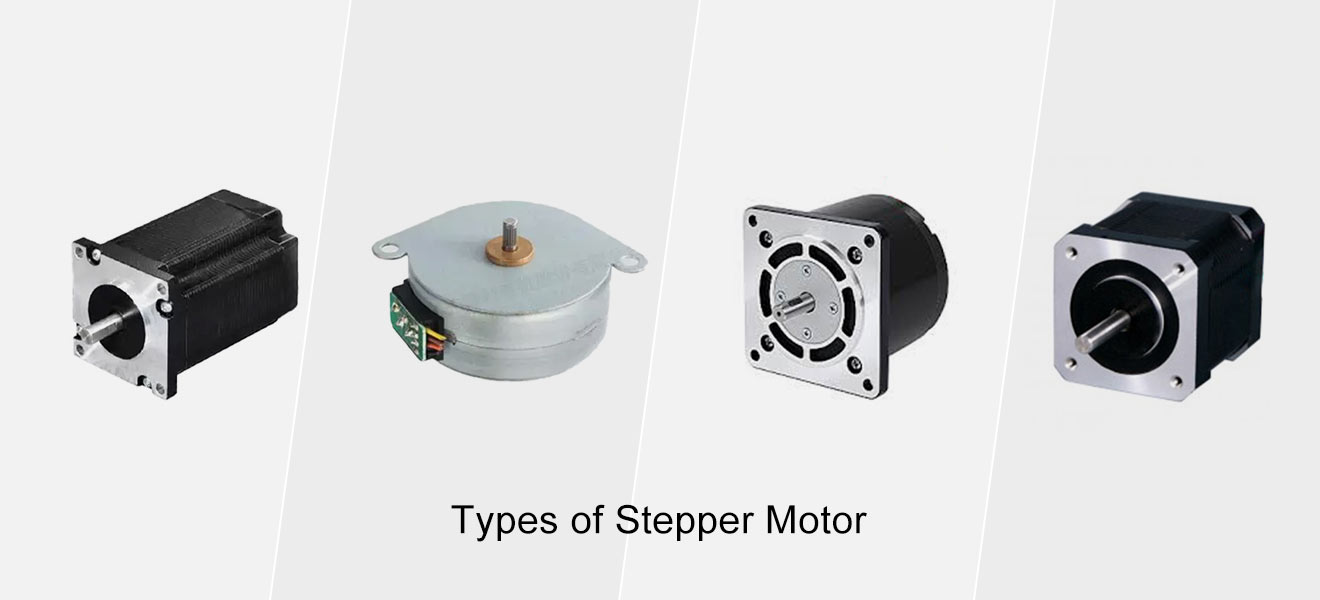Stepper motors are a popular choice for engineers and designers needing precise, repeatable motion control. They are employed in robotics, medical equipment, CNC machines, 3D printers, and other systems that need precise movement.
This article covers four main stepper motor types—Hybrid, Permanent Magnet, Variable Reluctance, and Synchronous—explaining how they work, their pros and cons, and ideal applications.
Understanding Stepper Motors
With stepper motors, a type of brushless DC electric motor, a whole revolution is divided into several equal steps. The rotor moves in distinct steps as the stator windings are energized in a predetermined order in their electromagnetically based operation. This property allows for open-loop control systems that eliminate the need for complex feedback mechanisms in many use cases.
Stepper motors are classified based on rotor and stator design, control methods, and performance characteristics. Let’s explore the four main types in depth.

1. Hybrid Stepper Motor
The design benefits of variable reluctance (VR) and permanent magnet (PM) stepper motors are combined in hybrid stepper motors. They offer improved performance in terms of precision, torque, and step resolution, making them the most popular type of stepper motor in industrial and commercial applications.
Both the rotor and the stator of hybrid stepper motors are toothed, and the rotor has a permanent magnet. This structure results in precise control of step angles—typically 1.8°, though smaller angles like 0.9° are also common.
| Pros | Cons |
| High precision and fine step resolution | Higher cost than PM or VR motors |
| Suitable for open-loop control systems | Generates heat at high speeds |
| High ratio of torque to inertia | More intricate driving circuits are needed. |
| Low detent torque when unpowered | Limited torque at very high speeds |
Applications:
- CNC Machines
- Robotics
- 3D Printers
- Surveillance Cameras
- Automated Optical Inspection (AOI) Systems
2. Permanent Magnet (PM) Stepper Motor
PM stepper motors lack the toothed structure present in hybrid stepper motors and instead use permanent magnets in the rotor. Their step angles, which range from 7.5° to 15°, are often bigger. They are more affordable and provide greater torque at lower speeds than hybrid motors, despite their lack of precision.
PM motors are often used in applications where high precision isn’t necessary, but simplicity and affordability are preferred.
| Pros | Cons |
| Economical and simple design | Lower precision than hybrid stepper motors |
| High torque at low speeds | Larger step angle limits fine movement |
| Easy to control | Not appropriate for situations requiring high precision |
| Reliable in low-speed operations | Noisy during operation |
Applications:
- Air Conditioners (for flap control)
- Camera Pan/Tilt Systems
- Automotive Gauges
- Entry-level Printers
- Household Appliances
3. Variable Reluctance (VR) Stepper Motor
There are no permanent magnets in VR stepper motors. They use the magnetic reluctance principle instead. The soft iron rotor shifts to the place of least resistance when the stator poles are turned on. These motors offer fast stepping response and are ideal for high-speed but low-torque applications.
Their step angle can be quite small (e.g., 1.2°), and they are often used in systems where lightweight and simple structures are a priority.
| Pros | Cons |
| Simple construction | Very low torque compared to other types |
| Quick response to input signals | Requires external driver logic |
| Inexpensive to manufacture | Poor holding torque |
| Excellent at high stepping rates | Unsuitable for high-load systems |
Applications:
- Automotive Dashboards
- Typewriters
- Early Plotters
- Industrial Measurement Instruments
- Basic Control Valves
4. Synchronous Stepper Motor
Synchronous stepper motors are a subset of stepper motors that maintain rotor position locked to the rotating magnetic field, enabling precise synchronization with the input pulses. They are sometimes considered a broader category under which stepper motors fall, but in this context, we refer specifically to synchronous motors with step characteristics used in control systems requiring exact positioning.
Unlike induction motors, synchronous stepper motors rotate at a constant speed determined by the supply frequency and are commonly used where timing and speed precision are essential.
| Pros | Cons |
| Precise speed and position control | Needs synchronizing circuitry |
| Low maintenance due to lack of brushes | More complex to control than basic stepper |
| High efficiency and constant speed | Poor performance in load fluctuation |
| Quiet operation in constant-speed settings | Requires feedback or start-up alignment |
Applications:
- Clocks and Timers
- Synchronous Conveyors
- Film Projectors
- Servo Positioning Systems
- Electric Meters
Stepper Motor Types: A Side-by-Side Comparison
| Feature | Hybrid Stepper | PM Stepper | VR Stepper | Synchronous Stepper |
| Rotor Type | Toothed + Magnet | Permanent Magnet | Soft Iron Core | Magnetized Synchronous Rotor |
| Typical Step Angle | 0.9°–1.8° | 7.5°–15° | 1.2°–15° | Variable |
| Torque (Low Speed) | High | Medium-High | Low | Medium |
| Torque (High Speed) | Moderate | Low | Very Low | Moderate |
| Precision | Very High | Moderate | Low | High |
| Cost | High | Low | Low | Medium |
| Control Complexity | High | Low | Moderate | High |
| Use Case Suitability | Industrial/Medical | Consumer Devices | Lightweight Devices | Timed Mechanisms |
Choosing the Right Stepper Motor for Your Application
Selecting the best stepper motor type involves understanding your project’s requirements in terms of torque, precision, cost, control system complexity, and application environment.
For High Precision & Industrial Performance
Choose Hybrid Stepper Motors. They are ideal for CNC, 3D printing, and robotics applications where precision and torque matter.
For Low-Cost and Simple Control Needs
Use Permanent Magnet Stepper Motors. These work well in consumer appliances and automotive dials with fewer movement requirements.
For Lightweight, Fast-Stepping Applications
Consider Variable Reluctance Stepper Motors. They are suited to light-load tasks where high-speed response is prioritized over torque.
For Precise Timing and Synchronization
Go with Synchronous Stepper Motors. Applications involving film transport, electric meters, or conveyors benefit from the constant speed and synchronization.
Integration with Controllers and Drivers
While stepper motors themselves are essential, their real power is unlocked when integrated with the correct driver circuits and controllers. Microstepping drivers, pulse generators, and encoders can enhance performance, especially in hybrid and synchronous motor applications. Open-loop systems are more common, but closed-loop stepper systems (also known as hybrid servos) are gaining popularity for applications that demand both accuracy and error correction.
Recent Trends in Stepper Motor Technology
Advancements in driver technology, such as digital signal processing (DSP) and microstepping algorithms, have enhanced the capability of stepper motors, particularly hybrid types. The push toward miniaturization has also made PM stepper motors a default choice for embedded electronics in consumer goods. Moreover, integration with IoT and wireless control systems is creating new opportunities for stepper motors in smart manufacturing and automation.
Final Thoughts
Stepper motors continue to evolve in step with modern engineering needs. Whether you’re designing a compact consumer gadget or an industrial-grade automation solution, understanding the distinct characteristics of each stepper motor type ensures your application runs efficiently, reliably, and precisely.

